The femtosecond laser is arguably one of the standout technological innovations in ophthalmic surgery of the 21st century. It debuted for study three decades ago. After its 1999 approval to create corneal flaps for LASIK surgery, it was first indicated for cataract removal in 2010. Its speedy proliferation is understandable: As a safe, precise cutting tool, the femtosecond laser is a natural candidate for a variety of surgical procedures, with femtosecond laser-assisted cataract surgeries (FLACS) currently accounting for most of its use.1-3 The device shines in difficult cases, and its potential continues to undergo intense investigation, with several applications in the approval process or already in clinical use.4-8
The following is an overview of the current state of offerings from the major femtosecond cataract laser manufacturers.
ALCON: LENSX
LenSx was the first platform approved for cataract surgery in the United States. Ongoing improvement has rendered it capable of LASIK and other procedures, as well. The SoftFit Patient interface is a proprietary hydrogel insert the company says allows for efficient and precise docking with minimal distortion, conforming to the ocular surface. The platform connects to the company’s Verion Image Guided system and built-in OCT empowers “on the fly” adjustment, the company notes.
The latest enhancements to receive FDA 510(k) clearance are indications for the creation of tunnels for intracorneal rings and pockets for presbyopia-correcting inlays. Software updates have been implemented to support the new indications and improve graphical user interface functionality, according to the company. Cosmetically, new gold and white exterior skin colors are intended to harmonize the appearance of the LenSx Laser with other Alcon technology in the surgical suite.
“The fact that Alcon’s platform does not have an affixed bed is a major benefit for my practice flow and efficiency — I keep the patient on the same stretcher and wheel them in and out of the laser room,” says Lawrence Woodard, MD, medical director of Omni Eye Services, Atlanta, Ga. “I also like the affixed patient interface, which allows for very good stabilization of the eye compared with liquid interface systems. I believe the eye is more stable, allowing me to create superior corneal incisions and more consistent capsulotomies.”
When it comes to complicated cases, Dr. Woodard says that the LenSx platform is a huge help. “Softening the lens with the laser in the setting of a dense brunescent cataract lets me use less ultrasound energy, which overall is better for the patient with less trauma to the corneal endothelium. I can also get in and out of the eye faster.”
It also plays a significant role for white cataracts, Dr. Woodard notes. “A manual capsulotomy in these patients may tear peripherally and lead to a posterior capsule rupture, whereas a laser procedure significantly lessens the chance of that happening. I still get a very accurately sized capsulotomy,” he says. “A cataract that has some zonular dehiscence and decentration of the lens will be unstable; laser capsulotomy, on the other hand, negates the issues related to zonular dehiscence that make the capsulotomy challenging.
BAUSCH + LOMB: VICTUS
Bausch & Lomb’s VICTUS laser was engineered for surgeries requiring initial lamellar resection of the cornea and anterior capsulotomies in cataract surgery, according to the manufacturer. The machine boasts a real-time, high-resolution RealEyez swept-source OCT component for planning and visualization throughout the procedure, and its curved Verafit patient interface monitored by intelligent pressure sensors is designed to minimize corneal fold. With pulse rates up to 160 kHz, the unit makes for quicker procedures and enhances surgeon control, the company states.
The Victus 3.3 software features an option for capsulotomy and lens fragmentation centration, providing surgeons the choice to center the procedure on the pupil, the limbus, the lens apex or other positions. Automatic pupil centration for the creation of corneal flaps is also included, and the software features a grid lens fragmentation pattern for additional options to individualize phacoemulsification. The system’s startup diagnosis and pre-selection of its startup mode has also been enhanced to improve usability and workflow as well as facilitate service and maintenance of the system.
Hardware includes an S60 bed that swings out farther from the laser, making it easy to get patients in and out during the procedure and simplifying workflow by allowing the phacoemulsification procedure to be completed on the same bed.
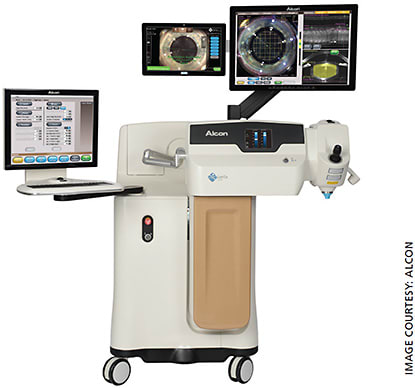
“Bausch + Lomb’s technology puts the ease and precision for creating corneal incisions front and center,” says Michael J. Endl, MD, a partner at Fichte, Endl & Elmer Eyecare in Amherst, N.Y., and head of ophthalmology at Ambulatory Surgery Center of Western New York in Niagara Falls. “I am a fan of the Victus’ curved interface, which is so important when making incisions on the cornea; it allows for a soft dock that is accurate and user-friendly. The fact that the LASIK flaps are done on the same machine is a bonus, and the dual function is ideal for my practice.” The cross sectional view for added visualization is also very helpful, he says.
“The latest advanced suction ring is a bright green color, providing a nice contrast to the limbus where the sclera meets the cornea. I can tell when I am perfectly centered more quickly than with a clear ring,” Dr. Endl says. “Manually, on the fly, I can change the position and size of the astigmatic incisions or the size of the flap just by moving the mouse. Add in the automatic pupil setting, and the entire process is quick and efficient.”
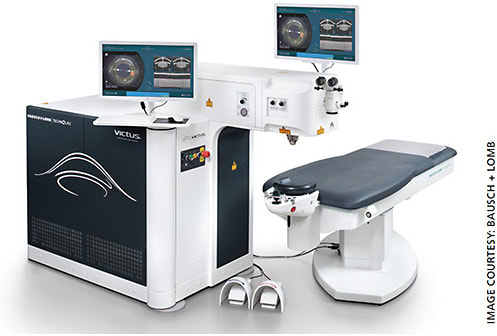
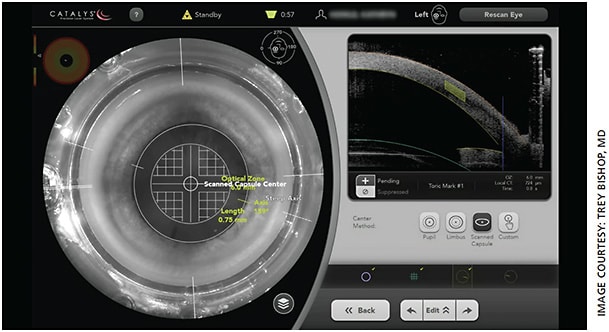
JOHNSON & JOHNSON VISION: CATALYS
Designed from as an aid to cataract surgery, Catalys uses 3D OCT Imaging and Integral Guidance Technology with guided delivery and automatic surface mapping to create precise and accurate incisions. Also, it uses corneal laser marks to help with toric IOL alignment, the company notes.
The platform continues to improve, the company says. It is now customizable for multiplanar clear corneal and planar paracentesis incisions during cataract surgery, as well as keratoplasty incisions in multiple configurations and intrastromal and penetrating arcuate incisions with greater control than mechanical instruments, J&J Vision says.
The most recent Catalys cOS 6.0 software with advanced astigmatism management is a collaboration with Cassini Technologies B.V. According to J&J Vision, the software simplifies astigmatism management workflow and increases operational efficiency.
“The Catalys Liquid Optics Interface makes it possible to create high quality, repeatable capsulotomies, reducing the variability in capsulorrhexis size, shape and centration,” says Trey Bishop, MD, founder and director of Cataract Care, Bishop Eye Center, Hilton Head, S.C. “This has a measurable impact on outcomes in my practice — I was able to reduce my enhancement rate in multifocal IOL cases from an already-low 3% to less than 1%.”
Recently, Catalys has added the ability to link to the Cassini Ambient with the cOS 6.0 software, which Dr. Bishop says greatly streamlines surgical planning and improves his results. “I’m able to make very accurate radial intrastromal laser marks along the steep axis of Cassini’s measured Total Corneal Astigmatism. This feature both obviates the need to manually enter anterior corneal data into formulas to adjust for posterior corneal effects and avoids the pitfalls of manually marking the cornea prior to surgery. This advancement has not only dramatically improved both accuracy and precision, but it has typically saved me more than one hour during a full OR day and numerous hours during a full week in clinic.”
LENSAR
The Lensar Laser System is the only femtosecond cataract laser built specifically for refractive cataract surgery, the company says. It has received four system upgrade in 2 years — most recently the Streamline IV. Key features include guidance for Precise Astigmatism Treatment Planning that allows LASIK-like outcomes for arcuate incision and toric IOL patients, the manufacturer says. Procedures have been simplified with pre-programmable surgeon preferences, an optimized graphical user interface, wireless integration with pre-op diagnostic data, cataract density imaging and automatic customized fragmentation patterns and arcuate incision planning at the laser.
With a corneal incision-only mode, the platform is efficient and has expanded remote diagnostics capabilities, additional pre-programmable preferences, surgeon-friendly ergonomics and reportedly up to 20 seconds faster laser treatment times, the company says. Its Augmented Reality provides an accurate 3-D model of the relevant anterior segment, so laser delivery is precise for accurate corneal incisions, free-floating capsulotomies and efficient lens fragmentation for all grades. By combining superior imaging of the anterior segment, precise laser placement and efficient lenticular fragmentation, the Lensar laser can reduce phaco time and even eliminate phaco energy in some cases.
Another new feature is the elliptical Patient Interface. The elliptical design mimics the actual shape and curvature of the eye, which allows surgeons to perform FLACS on patients with tight, palpebral fissures, deep orbits or redundant conjunctiva, the company says.
The recently announced Ally Adaptive Cataract Treatment System integrates femto and phaco in a single unit, marrying superior imaging, a next-generation, dual-pulse femto laser and astigmatic management technology in one small, multifunctional cataract treatment system.
“Lensar continues to innovate in the femtosecond laser space, and using it makes me a better and more predictable surgeon thanks to how it manages astigmatism,” says Elizabeth Yeu, MD, partner at Virginia Eye Consultants in Norfolk, Va. “Each advancement adds another advantage, like the IntelliAxis-C, which provides small, 7° intrastromal marks to identify the steep meridian, and the IntelliAxis-L, which creates a capsulorhexis with incorporated refractive markings that I can overlie with the hash marks on my toric IOLs.”
In addition, Dr. Yeu says Lensar streamlines data from different corneal topographers and uses internal nomograms to customize the locations and lengths of astigmatic keratotomies for lower levels of corneal astigmatism.
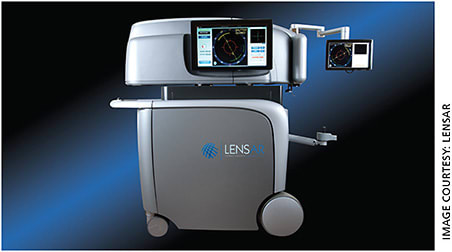
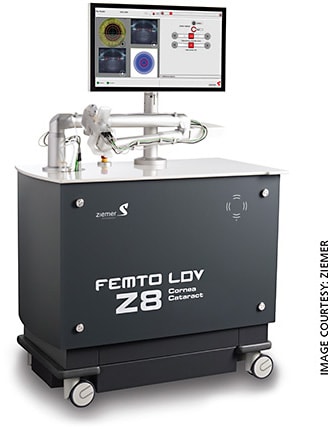
“Accuracy is improved because it is automatically transferred right into the system to account for iris registration and identify the proper magnitude of astigmatism and steep meridian,” Dr. Yeu says. “Eliminating cyclotorsion as a variable is a big deal; for every degree off the true steep meridian, 3% of the effective reduction is lost. With the platform, I have the highest level of confidence when implanting toric IOLs.”
ZIEMER OPHTHALMOLOGY: FEMTO Z8 NEO
Ziemer’s contribution to the ophthalmic femtosecond laser market is the FEMTO LDV Z. These units offer the highest repetition rate among femtosecond lasers, the company notes, as well as overlapping, precise spots with very low pulse energy. The laser is compact and mobile, simplifying workflow integration and eliminating the need to move the patient during surgery. Its GALILEI mapping module combines Placido topography, Dual-Scheimpflug tomography and optical biometry to optimize cataract and refractive surgery planning, making all measurements with one device.
The FEMTO Z8 NEO multipurpose laser platform is small and portable. At the same time, the device is safe and comfortable for the surgeon and patients as there is no need for patient transfer — the laser comes to the patient, also saving time, according to the manufacturer. The SLIM handpiece and patient interface conforms to most eyes and is an excellent docking experience, the company notes. With an enhanced cataract trajectory, the cutting time is faster and laser fragmentation is improved.
“The surgeon experience as well as the patient experience are seamless and comfortable,” says Neda Nikpoor, MD, surgeon at Aloha Laser Vision, Honolulu, Hawaii. “Since the Z8 is the only laser that can easily be used sterilely (ie, while the patient is prepped and draped and the surgeon is scrubbed in), there is no need to turnover between the laser and OR rooms. This allows for one continuous experience for the patient and the surgeon, which leads to improved comfort for the patient and improved efficiency for the surgeon.”
Also, the laser has a small footprint and is easily transported between facilities, Dr. Nikpoor says. “The Z8 has the added benefit of being a versatile laser that can be used for FLACS, LASIK flaps, and femtosecond laser-assisted keratoplasty.
In addition, because the Ziemer laser received approval in Europe for CLEAR, a SMILE-like procedure, “the future looks bright for this technology,” Dr. Nikpoor says.
CONCLUSION
Computer-controlled and guided by OCT, FLACS platforms are consistent, accurate and eliminate the possibility of a slip of the hand affecting the cut.
The continued improvements listed above indicate that femtosecond laser technology for cataract surgery is heading in the right direction. OM
REFERENCES
- Lawless M, Bala C. US Ophthalmic Review. 2014;7(2):82-88.
- Arons I. A Comparison of Commercially Available Femtosecond Lasers in Refractive Surgery. March 17, 2011. https://irvaronsjournal.blogspot.com/2011/03/comparison-of-commercially-available.html . Accessed August 1, 2021.
- Qureshi B. See the light – the evolution of femtosecond lasers. http://www.medicaldevice-developments.com/features/featuresee-the-light-the-evolution-of-femtosecond-lasers1-4935033/ . Accessed August 1, 2021.
- Titiyal JS, Kaur M, Singh A. Comparative evaluation of femtosecond laser-assisted cataract surgery and conventional phacoemulsification in white cataract. Clin Ophthalmol. 2016;10:1357-1364.
- Roberts TV, Lawless M, Sutton G, Hodge C. Update and clinical utility of the LenSx femtosecond laser in cataract surgery. Clin Ophthalmol. 2016; 10: 2021–2029.
- Nagy ZZ, Kranitz K, Takacs A, Filkorn T, Gergely R, Knorz MC. Intraocular femtosecond laser use in traumatic cataracts following penetrating and blunt trauma. J Refract Surg. 2012;28(2):151-153.
- Conrad-Hengerer I, Hengerer FH, Joachim SC, Schultz T, Dick HB. Femtosecond laser-assisted cataract surgery in intumescent white cataracts. J Cataract Refract Surg. 2014;40(1):44-50.
- Schultz T, Dick HB. Laser-assisted mini-capsulotomy: a new technique for intumescent white cataracts. J Refract Surg. 2014;30(11):742-745.








